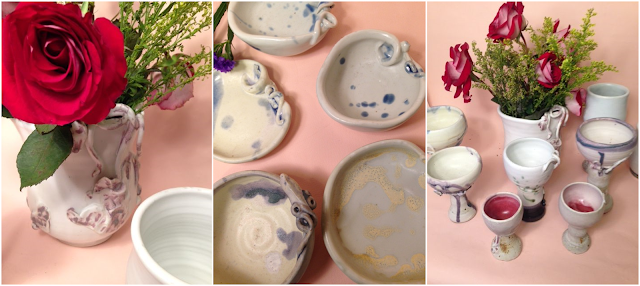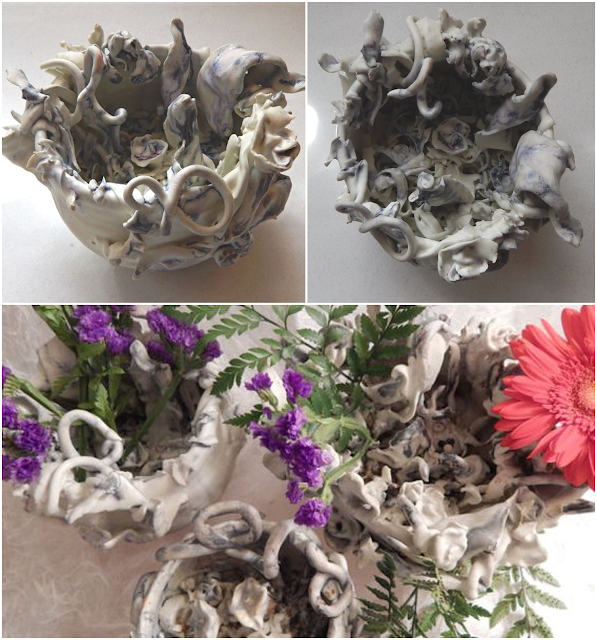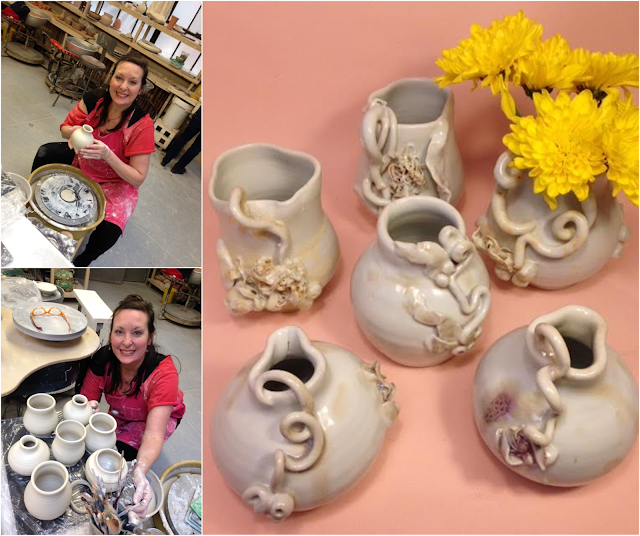 Today marks the debut of Everyday Artist on BoHo Home, a recurring feature in which I intervew working artists about their creative lives and showcase their art.
Today marks the debut of Everyday Artist on BoHo Home, a recurring feature in which I intervew working artists about their creative lives and showcase their art.
Cara Jean McCarthy of Cara Jean Clay has graciously agreed to be not only my first “Everyday Artist,” but sponsor of my very first GIVEAWAY! Keep reading for all the details and a look at her beautiful clay creations.
____________________________________________
Describe your art form and the art you produce.
I’m a ceramicist. I love that word, as it includes different kinds of clay bodies, from beautiful red earthen wares to luscious, satin-smooth porcelains, as well as all styles—functional, decorative and sculptural forms. I use the wheel to create shapes, and hand build decoration.
What drew you to the artist’s life?
I’ve always loved making things, all kinds of arts and crafts. My sisters taught me how to sew, and I loved making my own patterns and clothing (and later, costumes for dancers). And my very creative Aunt Jean dabbled in everything, from painting in oils and with laundry lint, to clay sculpture and carved apple-head dolls. She was inspiring, and always so wonderfully generous, constantly thinking of art projects for us to do with her. She let me play with clay, making small forms in her kitchen, and I always wanted to try working on a pottery wheel—always!
 |
|
Four differently glazed and decorated pitchers by Cara. (Cara Jean Clay photos)
|
Was ceramics always your artistic focus, or did you work in other art forms?
My first career was as a professional dancer. I was forced to take ballet class when I was six, but it stuck—I loved it! By my teenage years, I’d fallen in love with movie musicals—Gene Kelly and Fred Astaire. I dreamed of doing big movie musicals or becoming a dancer on TV. I loved dance ensembles on variety shows, particularly the Ernie Flatt dancers on the Carol Burnett Show, and in summer stock at places like Starlight Musicals in Indianapolis, where I fell in love with staged musicals and was absolutely thrilled to work one summer.
So I aimed for musical theater, since by the time I was ready to start my dance career, movie musicals weren’t being produced anymore. New York City became my focus and to be in musical theater and Broadway shows my goal. I was very lucky to have a performance, teaching and choreography career through age 41. By 2000 I’d retired from dance but stayed in New York, working in marketing and administration for various corporations. In January 2007, I took a ceramics class at an amazing and historic clay studio in the city’s West Village, called Greenwich House Pottery. That was the beginning of Cara Jean Clay.
 |
| These photos of Cara were taken by well-known dance photographer Milton Oleaga at Luigi‘s Jazz Studio, 62nd and Broadway, New York. Cara studied here after graduating Butler University and served on the teaching staff in the 1980s. |
I form (almost) everything on the wheel, then alter the shape, fit different parts together, add handles or décor of tiny hand-rolled coils, leaves, berries or flowers. Design-wise I’ve always been attracted to the luscious, intertwined lines of Erte’s graphic art and the nature-inspired embellishment of Bernard Palissy’s platters and rustic ware. I love how Palissy twisted and wove clay so that it seemed to come to life.
My first teacher was the dynamic Peter Lane, of Brooklyn—a spirited, hugely talented, nurturing artist who is now internationally renowned and collected. He encouraged, prodded, shared, lectured, coached, read to us, and inspired all things clay. Not a bit of clay could escape his attention; it all could be made into something.
 |
|
Cara forms the lip of a small vase on the pottery wheel at Greenwich House. She learned patience and diligence in dance, and finds it also at the heart of working in clay. (Gabriel Portuondo photos)
|
How has dance influenced you as a ceramicist?
My early dance training was to observe and then either mimic, recall, recreate, or improvise in movement. The observer’s eye became deeply ingrained, and now comes out in the clay. I love to make forms that appear to move, even in stillness. A dance teacher in my teen years and my mentor at Butler University in Indianapolis, Bud Kerwin, told us we should dance with “controlled abandon.” At first I thought the two words didn’t go together, and then the connection came to me in a flash of recognition, never forgotten.
 |
| Cara relays a story about the dance photographer, Milton Oleaga, who can be seen in reflection snapping the photo on the right. “He would take class, always dancing in the back row. Then during combinations he would grab his camera and start taking pictures. And then one day, if a dancer was very lucky, he would walk up to her (I saw it over and over), hand her an envelope and say shyly, ‘You might or might not want these.’ Of course they wanted them; they were gold! I felt so incredibly grateful when Milton handed me an envelope with these pictures.” |
When I came to New York after college, I studied with the great jazz master, Luigi [Eugene Louis Facciuto], whose mantra was “Never stop moving.” Both men meant the world to me, and I became the dancer I was because of them. They helped to mold and shape my technique, discipline and style in performance. Later, that transferred over into the clay. I’ve always believed we’re the blend of everything we’ve known, done or do. Everything trickles into other areas of our lives, and the disciplines of each can enhance the other.
 |
| L-R: A Medusa-like plate shown with a matching pitcher and smaller, less embellished pieces, an overhead view of the plate, and a closeup of its detail. (Cara Jean Clay photos) |
Where do you get ideas for your work?
Life! It’s a sensory overload! From objects in museums to flowers, gardens, designs on the sidewalk, sunlight, water, puddles, the waves of the ocean, ripples and splashes, sounds and smells, posters and magazines, flavors and spices, music and memories, people moving on the sidewalk or in the subway, as well as dance movement. All is seen and remembered, tucked away in my imagination.
 |
|
Patience is the key, Cara says. Sometimes she brings a pot up and down several times to help her center herself. (Gabriel Portuondo photos)
|
Describe your art-making routine and your studio or workshop.
Living in NYC requires constant creative use of time, energy and funds, from figuring out how to pay for studio time, classes, space or materials to keeping the lights on. I have a day job as a personal legal assistant at a law firm, and then I work every moment possible after work and on weekends at Greenwich House. My goal is to have my own studio space and shop space at some point, but for now, GHP is my home. It has both gas and electric kilns, as well as a huge variety of glazes and clays for potters to use. The technical staff there is wonderful.
How long does it take to complete a piece?
Smaller pieces, like my porcelain creamers, vases and Game of Thrones goblets, take a few weeks. After I form and embellish a piece, it has to dry thoroughly before going into the kiln for the first bisque firing. The thickness of the decorations I add determines drying time on the shelf. Most ceramic work is typically fired twice.
 |
| L-R, a selection of Cara’s simpler pieces: A small vase, “love shell” bowls, and her popular Game of Thrones goblets. (Cara Jean Clay photos) |
Prior to the second firing, I dip or paint on glazes or designs. I prefer using high-fire clays and glazes, as I feel the vitrified finish of the high-fire temperatures (up to 2,381 degrees F.) allows for sturdy use with liquids. My larger garden bowls and more complex wall pieces can take a few months from start to finish because of the dramatic layers of decoration. Drying time is key, and patience is the lesson in clay, always.
 |
| L-R: “Champagne Gardens Punch Bowl,” and “Water Angel Garden,” which can function as part of a garden water feature, hanging, or lying flat. (Cara Jean Clay photos) |
What’s your favorite piece?
A two-piece porcelain set, glazed in a satin-smooth matte white with blushes of pink called “Angel Whispers.” It’s a large hand-pressed bowl with a pitcher that sits inside the bowl, reminiscent of the bowls and pitchers that sat on dressers in Victorian-era homes. The pitcher has a plant-like leaf and vine handle, and small bits of hand-rolled flowers and berries decorate the bowl and the vase in a Victoriana Nouveau style.
 |
| The two-piece set, “Angel Whispers,” viewed from the side, overhead, and filled with roses. This bowl and pitcher set is Cara’s favorite piece, and she created it as an homage to her grandmother. (Cara Jean Clay photos) |
It reminds me of my grandmother’s Victorian home in Anderson, Ind., and it feels like a decorative homage to her strength and love. And I do love filling it with huge bouquets of roses and trying to capture photos of it in shadowy, almost mysterious, sunlight.
My early pottery was often entirely covered in décor, sometimes inside and out—wild and crazy and so much fun to make. The hardest part was taking my hands off and stopping. More recently, my style has become quieter and more focused, with occasional bursts of wild and crazy. So I may return to produce another effervescent garden-like bowl and teacups in between collections of quietly etched cups, vases, and goblets. Beads for necklaces, ornaments and beaded curtains also made their way into my repertoire last fall. There’s so much more to do, much more to come. I try to stay open to letting new ideas and forms flow without worrying about production or selling.
 |
| Four views of the “Desert Rose” vase, including one in which it’s filled with flowers. Cara loves to photograph her finished clay pieces with flowers. “My motto is there are never enough flowers,” she says. (Cara Jean Clay photos) |
Do you ever get blocked? How do you deal with it?
I usually have more ideas than time available to be in the studio. But if I’m ever feeling out of sorts, I find a quiet place in my mind and use the clay to help me relax. I focus on centering, twirling clay in my hands, and try to listen to my breathing, clear my mind, and get to the place I need to be to center the clay. If I’m not focused, it will show up in my hands. Sometimes I need simply to center and throw a piece, only to push it back down, and pull it up again into a new shape a few times before keeping a form. It’s like warming up for dance, but I’m finding the ritual in my hands.
What other artists inspire you?
Dance-wise, Rudolf Nureyev, who seemed to fly above and around the stage and whose eyes burned with inner knowing. I saw him several times in performance, twice with Margot Fonteyn. For a young dancer, those were life-altering moments. I also love Chopin’s music—haunting, lingering melodies my father used to play late at night when he thought no one was listening. My father, Carl, was an inspiration in himself, a bit of a Renaissance man with talent in music and art, as well as a love of history, old movies and everything railroad.
 |
| The inner embellishment in these vases hold flowers in place, thus eliminating the need for a flower-arranging “frog.” (Cara Jean Clay photos) |
I love Vincent van Gogh, whose thick, emotion-laden brushstrokes personify beauty, madness and light. I feel his paintings viscerally. I also had the honor of creating choreography to the music of Slam Stewart, a well-known jazz bassist of the 1940s and co-composer of “The Flat Foot Floogie.” He was a true jazz gentleman, and I remain drawn to his music’s rhythmic movement and style.
What advice would you give aspiring artists?
Never stop learning! Read, study, watch, learn, observe, and soak up as much as possible. Go to lectures, museums, galleries, studio tours, and exhibit openings. Learn from old masters and current elders. Lark Publishing has a wonderful series of books called the 500 series—500 teapots, 500 tiles, 500 plates, and many more. They’re a lovely starting point for shapes and glaze ideas, and cover so many forms of artistic expression.
 |
| At left, Cara finishes throwing first one, then a group of small vases on the pottery wheel. Next she’ll add clay decoration, dry, fire, glaze/paint and fire again. At right is the same group of vases, finished and ready for sale. (Gabriel Portuondo and Cara Jean Clay photos) |
How do you market your work?
I love taking photographs of the clays and have been adding to my website for a few years. I’m also on Etsy, Instagram, Facebook, and Pinterest. I exhibit whenever and wherever I can. Check one of my social media sites to learn where I’ll be next, or purchase straight from the sites through PayPal.
- Like the BoHo Home Facebook page.
- Like Cara Jean Clay’s Facebook page.
- Browse Cara Jean Clay’s Etsy shop and/or her website and find a piece you really like.
- Return to this blog post, and leave a comment, indicating you “liked” both Facebook pages and what piece from Cara’s Etsy shop caught your eye.
- BONUS ENTRY: Get a second chance in the drawing if you follow BoHo Home on Bloglovin’ (a social media site for keeping up to date with all the blogs you like in one place), or by email using the link in the sidebar, then leave ANOTHER comment saying which you chose.


